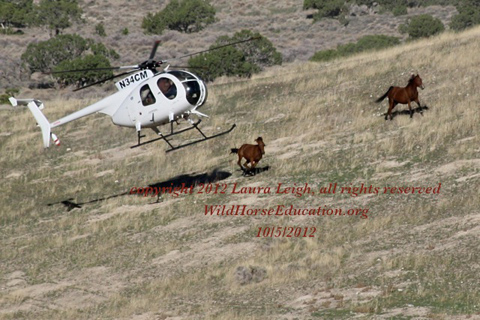
Whatever your views on how to deal with the wild horse “situation” I hope you agree that the Bureau of Land Management has done a truly awful job of managing it.
A press release (below) from the Wild Horse Preservation organization gives an example. Thanks to my brother John Beal for finding this.
Today, the American Wild Horse Preservation Campaign (AWHPC), a national coalition, reacted with outrage and disbelief at the Bureau of Land Management’s (BLM’s) plan, released today, to roundup and remove 1,300 wild horses and burros from public lands this summer, bringing to 4,800 the total number removed in Fiscal Year 2013. The captured animals will be added to holding facilities that are already at capacity with 50,000 wild horses and burros stockpiled at taxpayer expense.
The intensive and unjustified mustang removal plan comes despite last month’s recommendation by the National Academy of Sciences (NAS) recommendations against further roundups and in favor of an intensive fertility-control program. The agency is cloaking the proposed removals as emergencies, however AWHPC said that many of the roundups are unnecessary and are not emergencies, such as those proposed for Murderers Creek (OR), Little Book Cliffs (CO), Snowstorms (NV), Fish Lake (NV), and Hickison (NV).
“The BLM is galloping ahead with rounding up more wild horses, despite the high cost to taxpayers and animals as well as the findings of an independent scientific review, which recommends against continued roundups,” said Suzanne Roy, AWHPC communications director. “The agency still has not gotten the message that the removal of wild horses from our Western public lands is inhumane, unsustainable, unscientific and must come to an end.”
After a nearly two-year review, which the BLM commissioned and spent $1.4 million to underwrite, the NAS issued a scathing report in June, which concluded that “Continuation of ‘business as usual’ practices will be expensive and unproductive for BLM and the public it serves.” The report also found that BLM management practices were causing wild horses to reproduce at their biological maximum and increasing the number of horses added to holding facilities. Significantly, the NAS found that “Tools [including PZP fertility control] already exist for BLM to address many challenges” but that the BLM was under-utilizing this proven management method.
“The BLM must begin immediately to manage wild horses on the range,” said Neda DeMayo, president of Return to Freedom, AWHPC’s founding organization. “The federal government has the technology to minimize wild horse removals by managing horses on their rangelands as recommended by the National Academy of Sciences. With 50,000 wild horses in government holding facilities, we are hopeful that Interior Secretary Sally Jewel will step in and change BLM’s business as usual practices — or the threat of slaughter will continue to hang over the heads of warehoused wild horses.”
Last month, AWHPC and Return to Freedom, joined by over 30,000 America citizens — including 30 members of Congress and celebrities such as Robert Redford, Carole King, Ali MacGraw, Viggo Mortensen, Ed Harris, Noah Wylie, Wendie Malick, Betty White and Valerie Bertinelli — in calling on Secretary Sally Jewell to step in to protect wild horses and reform the BLM program. Additionally, a recent poll on the issue showed that 72 percent of Americans support protecting wild horses and burros, and that support cuts across party and gender lines.
The newly-released roundup schedule includes many “non-emergency” roundups, including the removal of up to 50 horses from the famed Little Book Cliffs Wild Horse Range in Colorado. According to AWHPC, this proposed roundup is a perfect example of the BLM’s refusal to properly implement fertility control. At the Book Cliffs, the BLM has only administered fertility control to approximately half of the breeding-age mares to purposefully allow breeding to continue, leading to the removal of horses. The agency has repeatedly stated its intent to continue the unsustainable approach of routine wild horse roundups instead of properly using humane fertility control to minimize removals to verifiable emergency situations only.
Other key findings of the NAS report include:
Management practices are facilitating high rates of population growth.… As a result, the number of animals processed through holding facilities is probably increased by management.
In the short term, more intensive management of free-ranging horses and burros would be expensive. However, addressing the problem immediately with a long-term view is probably a more affordable option than continuing to remove horses to long-term holding facilities.
The committee could not identify a science-based rationale used by BLM to allocate forage and habitat resources to various uses within the constraints of protecting rangeland health and listed species and given the multiple-use mandate.
How Appropriate Management Levels (AMLs) are established, monitored, and adjusted is not transparent to stakeholders, supported by scientific information, or amenable to adaptation with new information and environmental and social change. Standards for transparency, quality and equity are needed in establishing these levels, monitoring them and adjusting them.
Horse and burro management and control strategies cannot be based on biological or cost considerations alone; management should engage interested and affected parties and also be responsive to public attitudes and preferences.
Three decades ago, the National Research Council reported that public opinion was the major reason that the Wild Horse and Burro Program existed and public opinion was a primary indicator of management success (NRC, 1982). The same holds true today.
